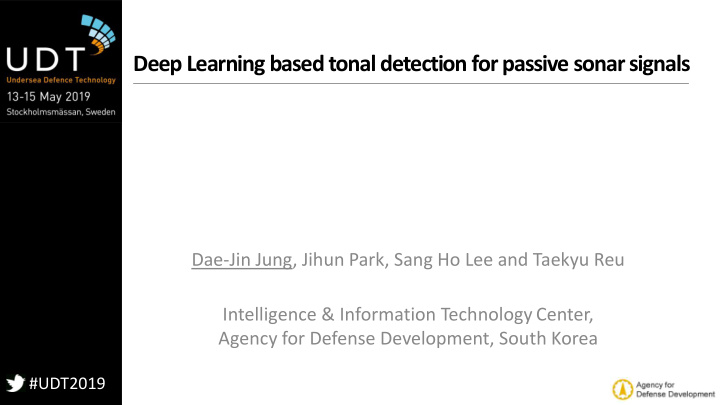



Deep Learning based tonal detection for passive sonar signals Dae-Jin Jung, Jihun Park, Sang Ho Lee and Taekyu Reu Intelligence & Information Technology Center, Agency for Defense Development, South Korea #UDT2019
Introduction • Underwater target detection • SONAR o Acoustic signals : best propagation under the water (Others have severe attenuation under the water) o Sole technique for underwater target detection o Most military systems use passive SONAR o SONAR signal analysis : LOFAR / DEMON #UDT2019 2
Introduction • Source (target) classification process analyzed manually Short-Time Spectrogram Time-series Tonal Line Source Fourier Image Sonar Waves Detection Classification Transform (LOF AR/ DEMON) base step for analysis • Manual Process o Dependent on personal ability o Time-consuming (analysis / training analysts) o Likely to make a few mistakes • Automated method is required for accurate/fast identification • Adopt deep learning to this problem #UDT2019 3
Introduction • Tonal line detection examples • Desired • Conventional methods #UDT2019 < thresholding > < adoptive thresholding – Otsu method > < peak detection > 4
Proposed Method Time-series Data CNN Simulator LOFAR image Sonar waves Augmentation Train/Validation Simulation Ground Truth Parameters creation • Use of CNN (Convolutional Neural Network) • Great performance in pattern recognition • Use of simulator • Difficulties in access to real SONAR data • Easiness of creating training data #UDT2019 5
Time-series Sonar CNN Simulator LOFAR image Data Augmentation waves Train/Validation Simulation Ground Truth Parameters creation Proposed Method - Simulator 3 images Sensor Data Scenario Information < Scenario Editor > < Signal Generator > < Signal Processor > #UDT2019 < Scenario Editor > < Signal Processor > 6
Time-series Sonar CNN Simulator LOFAR image Data Augmentation waves Train/Validation Simulation Ground Truth Parameters creation Proposed Method - Simulator Parameters Scenario editor Sensor setting < Target settings > < Sensor settings > Scenario Target setting manager Ocean environment Scenario DB setting #UDT2019 < Ocean environment settings > 7
Time-series Sonar CNN Simulator LOFAR image Data Augmentation waves Train/Validation Simulation Ground Truth Parameters creation Proposed Method - LOFAR image/Ground Truth • LOFAR image • Single target scenario (target speed : 0) • S3PM : Normalization (window size : 17 / gap size : 3) • Frequency resolution : 0.5 Hz • Short-time integration : 2 seconds • Ground Truth creation using scenario data #UDT2019 8
Time-series Sonar CNN Simulator LOFAR image Data Augmentation waves Train/Validation Simulation Ground Truth Parameters creation Proposed Method - Data augmentation • Various data creation • Target motion simulation using image manipulation (Image row (frequency) shifting) • No consideration for harmonics • Gaussian probability density function 2 1 𝑓 −1 𝑦−𝜈 𝑦 = 2 𝜏 𝜏 2𝜌 rotate #UDT2019 9
Time-series Sonar CNN Simulator LOFAR image Data Augmentation waves Train/Validation Simulation Ground Truth Parameters creation Proposed Method - Data augmentation • Data augmentation • Frequency-shift function Start point 𝑔 𝑦 = 𝑒 ∗ 𝑛 ∗ 𝑦 + ms Randomly choose o d ∊ {-1, 1} : directivity o End point m=[20, 40] : magnitude o ms=[-10, 10] : magnitude-shift o Random selection of start-point • Example #UDT2019 10
Time-series Sonar CNN Simulator LOFAR image Data Augmentation waves Train/Validation Simulation Ground Truth Parameters creation Proposed Method - CNN Train/Validation • CNN (Convolutional Neural Network) • U-Net o Fully convolutional network for semantic segmentation o Tonal line detection can be considered as semantic segmentation < prediction result > < U-net prediction example > o Cons – Imbalanced training sets (# of tonal line pixels << # ambient noise pixels) #UDT2019 – Dependency on image size (should be multiple of 16) 11
Test results - settings • 312 scenario data Model 1(U-Net) Scenario # (10 min/scenario) 312 Data augmentation X20 (6,240 pairs) Train/Validation Data # 2,640 / 3,600 images • Workstation specification • 4 GPUs (NVidia Titan XP – 12GB) • 128 GB RAM #UDT2019 12
Test results - results • Trained model test results • Detection result criteria o Tolerate 1 pixel (0.5Hz) displacement Train data Validation data Precision 0.9959 0.9618 Recall 0.9045 0.9206 Prediction time 0.3217 (sec) (10-minute LOFAR image) #UDT2019 13
Test results - results • Example • Tonal line detection • Suppression of ambient noises False positive False positive #UDT2019 < LOFAR image > < prediction result > < ground truth > 14
Test results - results • Example • Tonal lines hardly detected by human eyes < LOFAR image > < prediction result > < ground truth > #UDT2019 15
Test results - results • Example • False positivies #UDT2019 < LOFARgram > < prediction result > < ground truth > 16
Test results - results • Results in different time-unit executions (Model - 1) • 480 sec example (using Sliding window) < Time Unit : 16 sec > < Time Unit : 32 sec > < Time Unit : 48 sec > < Time Unit : 480 sec > #UDT2019 < Time Unit : 64 sec > < Time Unit : 80 sec > < Time Unit : 96 sec > 17
Conclusions • Automated sonar tonal detection • Good performance on synthetic simulation data • Image based training • Connection between disconnected lines • Accurate, Speedy • Future work • Trying various CNN architectures • Extraction of various information for ship classification • Validation task on real data #UDT2019 18
Recommend
More recommend